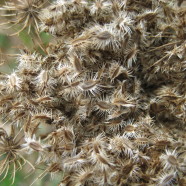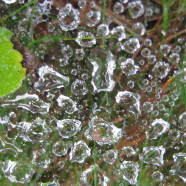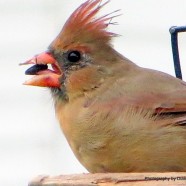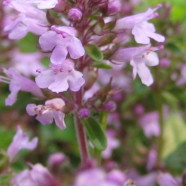Queen Anne’s Lace: Re-opening for Business
Queen Anne’s lace really stands out in a crowd when it’s in bloom. The big umbrella-shaped white flowers are hard to miss. But when fall comes, the plant closes up shop. The round flower head clenches itself up like a fist and forms a tight brown clump sometimes known as a “bird’s-nest.” It’s not a nest for birds, it’s more of a restaurant, since the birds come and check out the clumps for insects and spiders that might be hiding inside. Then, the amazing part–the Queen Anne’s lace flower, apparently dead, stiff and dried-up, re-opens. It...
Read MoreDoorways in the Grass: Funnel Web Spiders
Trailside, on a damp October morning. Circles of diamond dew-drops, magically suspended above the ground in neat circular patterns. I had to look closely to see the threads of web that held up the water droplets, and even more closely to see the funnel-shaped door at the top of the circle. The home of the funnel web spider. I’ve always loved the sight of these dainty webs, like lace handkerchiefs strewn across the ground. And sometimes I can’t resist the temptation to tap one with a finger and watch the little spider dart out to see if dinner has arrived, and then vanish back...
Read MoreVirginia Creeper: Blood Red
Now there’s a scary name for a plant. The Virginia Creeper. Sounds like something you’d want to stay away from around Halloween, for sure. It’s a native American plant that’s common in wooded areas, and it grows so prolifically that you’d think it would be easy to encourage it to grow in your backyard, but like all wild things, it’s tricky to domesticate. Wildings have a tendency to grow where they darn well choose, living life on their own terms, ignoring humans’ best efforts to pamper them. I’ve tried to lure the Creeper up my trellis, get it to drape...
Read MoreViper’s Bugloss: Snake in the Grass
This lovely snake is not a viper, far from it–a more harmless and gentle little creature never lived. It’s a grass snake, also known as a green snake, who crossed my path on a hiking trail in New Brunswick, and obligingly posed for photographs before melting into the ferns on the side of the trail. Funny, when I parked the car at the trailhead, I noticed a beautiful blue plant lurking next to the garbage can–viper’s bugloss. A strange name. It’s a Eurasian import, and “Bugloss” has ancient Greek roots meaning ox tongue, which probably refers to the...
Read MoreThe Dishevelled Cardinal
Thanks to Diane Hale Smith for this photo of a female cardinal having, as she put it, “a bad feather day.” Look at that beak–built like a nutcracker to crush the hard shells of sunflower seeds. Cardinals love feeders as much as we love watching them. Their bright red plumage seems made for inept birdwatchers like me who can never spot the little brown birds hiding high up in the branches. Cardinals don’t flee the snow and cold, they hang around all winter, brightening up the drabbest months. It’s hard to imagine this tiny morsel of a bird surviving subzero...
Read MoreWild Thyme: Bee Harvest
Funds are tight everywhere these days, and one thing that must have gotten slashed from the budget of the Florida, NY Town Hall is mowing. Of course there’s not a lot of lawn to mow in front of the town hall, it’s just a tiny oval island of green in a sea of blacktop. Usually it’s scalped into a brutally short crew cut, but this year they’ve let it run wild. Which is to say, the grass must be quite two inches long. And intermixed with the grass are several large purple patches of thyme. Lying on my stomach on this sun-warmed savory blanket, I can see the honeybees bumbling around among...
Read More










Recent Comments